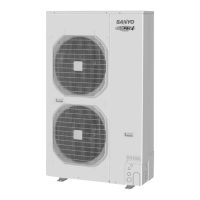1
1-93
Indoor air intake temp (WB)
Indoor air intake temp (WB)
Indoor air intake temp (°C DB)
Indoor air intake temp (°C DB)
1-7. Capacity Correction Graph According to Temperature Condition
60
80
80
60
40
100
120
140
22WB
19WB
16WB
22WB
19WB
16WB
3525155-15 45
100
120
140
-5 -10 5010-5
120
40
60
80
100
120
40
60
80
100
-15 15-20
16
20
24
16
20
24
1.0 1.0 0.97 0.96 0.96 0.95 0.94 0.890.91 0.88 0.87 0.870.87 0.88 0.89
-20 -15 -10 -9 -8 -7 -6 -5 -4 -3 -2 -1 0 1 2 6543
1.00.950.91 0.92
SPW-C706 / 906VH8
Max. Capacity & Input Change Characteristics When the Outdoor Air Temperature Changes :
For 50 Hz and 60 HzFor 50 Hz and 60 Hz
Capacity coefficient (%)Input coefficient (%)
Cooling capacity ratio (maximum capacity) Heating capacity ratio (maximum capacity)
Outdoor air intake temp (°C DB) Outdoor air intake temp (°C WB)
Outdoor unit heating capacity correction coefficient during of frosting/defrosting
3. The heating capacity of this table excludes the capacity failure under the condensation (including the defrosting drive).
2. The circle mark " " shows the maximum efficiency and maximum power consumption under the standard condition.
* The maximum efficiency shows the maximum value in the parenthesis of the specifications
(cooling and heating capacity).
1. The characteristics of this table shows the values under the following condition.
Piping equivalent length 7.5m
High & low difference 0m
Airflow rate High
(RH approximately 85%)
Outdoor intake air
temperature
°C WB
Correction coefficient
To calculate the heating capacity with consideration for frosting/defrosting operation, multiply the heating
capacity found from the capacity graph by the correction coefficient from the table above.
Capacity coefficient (%)Input coefficient (%)
NOTE:
SM830161Book.indb93SM830161Book.indb93 2008/06/039:08:052008/06/039:08:05

